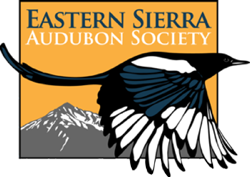Southern Sierra Desert Canyons Important Bird Area
Text and photos from National Audubon Society IBA Database Site Profile
Southern Sierra Desert Canyons Site Description
From the road to Kennedy Meadows in southwestern Inyo County to the southeastern Sierra Canyons just north of the Tehachapi Mountains, desert winds carry aloft a raft of birds desperate to arrive on their breeding grounds at or just beyond these migratory pathways in nearby mountains and valleys. As one of Interior California?s most critical segments of the Pacific Flyway, these canyons cannot be replaced for their value as breeding and migratory stopover habitat. The elevation of the migratory passages runs from a low of 2018 ft. at Cantil to a high of 8452 ft at Owens Peak. As the elevation drops from the peaks of the eastern Sierran Mountains the climate changes from Mediterranean temperate to hot dry desert monsoonal. Localized habitats follow the shift in elevation from the top of Owens Peak with its mixed conifer series vegetation to creosote woodland in the lower elevations near State Highway 14. The geology of the area is varied with Sierran granite dominating the peaks and ancient volcanic basalt and pumice rising above the quaternary alluvium. Butterbredt Spring and Canyon have unique biological values that deserve permanent protection for the benefit of wildlife. The diversity of habitats around the spring and seep is remarkable: it supports cottonwood/willow riparian with a cattail marsh. The upland areas support Joshua tree woodland and Mojave creosote woodland. It is within the Bureau of Land Management?s Jawbone-Butterbredt Area of Critical Environmental Concern (ACEC). In the Butterbredt Canyon alone, over 50 species of birds are documented to nest with 15 named as sensitive to endangered species. Nearby canyons have similar but not well documented occupancy due to lack of observers and access. This proposed IBA encompasses the canyons leading from the NW Mojave Desert to the Sierra Nevada in eastern Kern County and southwestern Inyo County.
Conservation Issues
Wind Development is the most imminent threat with their associated transmission towers providing nesting strata for a variety of predator species especially corvids. Unrestricted access by motorcyclists is the second most prominent threat to habitat and nesting species. Unregulated hunting with no bag limit enforcement is a third threat. Solar energy fields in the lowlands have demonstrated a threat as migrating birds can potentially mistake them for water sources, crashing into the arrays.
Ornithological Summary
Eastern Sierra Canyons are known to be one of the more important migratory routes in the interior Pacific Flyway. The independent sightings of all birders are hard to come by but by February 2012, 256 species of birds have been documented as passing through or residents. Of these 55 species have special status ranging from Audubon watch list birds to federally endangered species with full-habitat protection plans. Of the 53 species known or suspected to be nesting within just Butterbredt Canyon, 17 are designated sensitive. Two of these species have not been documented as nesting but are suspected: Brown-crested Flycatcher and Least Bell's Vireo.
How significant are these canyons to migration? On May 8, 2010, Andrew Howe reported counting birds as they flew up the canyon during migration, "estimated 40,000 to 45,000 migrants stream up canyon, the bulk of the movement flying by every single second." A similar phenomenon was observed by Susan Steele and Alison Sheehey on May 5, 2010, with at least half of this number streaming by during an early morning visit. High wind appears to keep the birds low to the ground which provides the opportunity to document the large number of individuals migrating through the area.
Most bird observations are done each spring with the massive migration. The Santa Monica Bay Audubon Society conducts an annual Christmas Bird Count centered around Butterbredt Spring. The following status species are known or suspected to be nesting just within Butterbredt Canyon:
- American Bittern
- American White Pelican
- Bald Eagle
- Bank Swallow
- Bell's Vireo
- Bendire's Thrasher
- Black Swift
- Black-chinned Sparrow
- Black-crowned Night-Heron
- Black-tailed Flycatcher
- Brewer's Sparrow
- Brown-crested Flycatcher
- Burrowing Owl
- California Gull
- Chipping Sparrow
- Cooper's Hawk
- Costa's Hummingbird
- Double-crested Cormorant
- Flammulated Owl
- Golden Eagle
- Great Blue Heron
- Great Egret
- Hermit Warbler
- Horned Lark
- Lark Sparrow
- Lawrence's Goldfinch
- Le Conte's Thrasher
- Loggerhead Shrike
- Long-eared Owl
- Merlin
- Northern Harrier
- Nuttall's Woodpecker
- Oak Titmouse
- Olive-sided Flycatcher
- Osprey
- Peregrine Falcon
- Prairie Falcon
- Purple Martin
- Red-winged Blackbird
- Rufous Hummingbird
- Rufous-crowned Sparrow
- Sharp-shinned Hawk
- Snowy Egret
- Summer Tanager
- Swainson's Hawk
- Tricolored Blackbird
- Vaux's Swift
- Vermilion Flycatcher
- White-faced Ibis
- White-headed Woodpecker
- Willow Flycatcher
- Yellow Warbler
- Yellow-billed Cuckoo
- Yellow-breasted Chat
- Yellow-headed Blackbird
Help us learn more about the birds at this IBA! Enter your birding data online at California eBird! (http://ebird.org/california/)
Click here for a bar chart of eBird observations in Southern Sierra Desert Canyons


